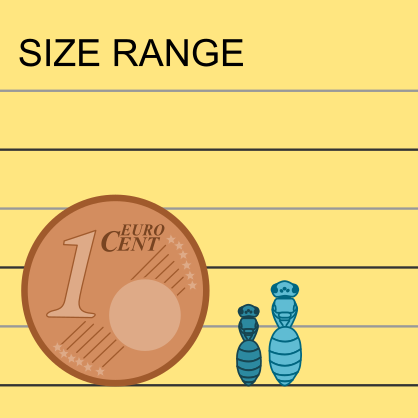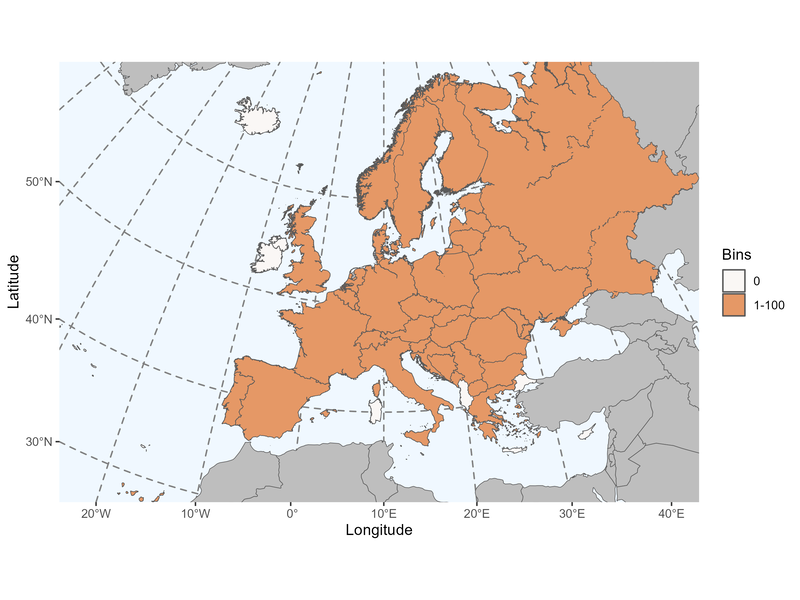Author: Kirby, 1802
|
Type species: Melitta tricincta Kirby, 1802, by designation of Richards, 1935: 172.
Synonyms: Cilissa Leach, 1812; Kirbya Lepeletier, 1841; Pseudocilissa Radoszkowski, 1891; Brachycephalapis Viereck, 1909. |
Clade: Anthophila
Family: Melittidae SubF: Melittinae Tribe: Melittini |
|
Distinctive traits
|
Pictures of distinctive traits.
|
Morphologically close genera and how to distinguish them
Andrena species have two subantennal sutures, females have facial foveae and the last tarsal segment is of similar width than the previous tarsal segments.
Dasypoda & Macropis species present 2 submarginal cells and a normal last tarsal segment.
Colletes species have a bifid glossa and an S-shaped second recurrent vein.
Halictus species have a strongly curved basal vein. Females have a bald furrow at the apex of their 5th metasomal tergite
- Melitta - Andrena
Andrena species have two subantennal sutures, females have facial foveae and the last tarsal segment is of similar width than the previous tarsal segments.
- Melitta - Dasypoda & Macropis
Dasypoda & Macropis species present 2 submarginal cells and a normal last tarsal segment.
- Melitta - Colletes
Colletes species have a bifid glossa and an S-shaped second recurrent vein.
- Melitta - Halictus
Halictus species have a strongly curved basal vein. Females have a bald furrow at the apex of their 5th metasomal tergite
General comments on Melitta species identification
Species identification requires genitalia observation in males and mouthparts in females. Mouthparts should therefore be extended and mandibles open whenever possible.
Species identification requires genitalia observation in males and mouthparts in females. Mouthparts should therefore be extended and mandibles open whenever possible.
Sorry, but the species identification tool is not yet available for Melitta.
Please check the reference(s) below for traditional keys.
Please check the reference(s) below for traditional keys.
List of the 19 Melitta species found in Europe (Ghisbain et al. 2023):
Melitta (Melitta) aegyptiaca (Radoszkowski, 1891)
Melitta (Melitta) budashkini Radchenko & Ivanov, 2012
Melitta (Melitta) budensis (Mocsáry, 1878)
Melitta (Melitta) dimidiata Morawitz, 1876
Melitta (Melitta) haemorrhoidalis (Fabricius, 1775)
Melitta (Melitta) hispanica Friese, 1900
Melitta (Melitta) iberica Warncke, 1973
Melitta (Melitta) kastiliensis Warncke, 1973
Melitta (Melitta) leporina (Panzer, 1799)
Melitta (Melitta) maura (Pérez, 1896)
Melitta (Melitta) melanura Nylander, 1852
Melitta (Melitta) murciana Warncke, 1973
Melitta (Melitta) nigricans Alfken, 1905
Melitta (Melitta) schmiedeknechti Friese, 1898
Melitta (Melitta) seitzi Alfken, 1927
Melitta (Melitta) sibirica (Morawitz, 1888)
Melitta (Melitta) tomentosa Friese, 1900
Melitta (Melitta) tricincta Kirby, 1802
Melitta (Melitta) udmurtica Sitdikov, 1986
Melitta (Melitta) aegyptiaca (Radoszkowski, 1891)
Melitta (Melitta) budashkini Radchenko & Ivanov, 2012
Melitta (Melitta) budensis (Mocsáry, 1878)
Melitta (Melitta) dimidiata Morawitz, 1876
Melitta (Melitta) haemorrhoidalis (Fabricius, 1775)
Melitta (Melitta) hispanica Friese, 1900
Melitta (Melitta) iberica Warncke, 1973
Melitta (Melitta) kastiliensis Warncke, 1973
Melitta (Melitta) leporina (Panzer, 1799)
Melitta (Melitta) maura (Pérez, 1896)
Melitta (Melitta) melanura Nylander, 1852
Melitta (Melitta) murciana Warncke, 1973
Melitta (Melitta) nigricans Alfken, 1905
Melitta (Melitta) schmiedeknechti Friese, 1898
Melitta (Melitta) seitzi Alfken, 1927
Melitta (Melitta) sibirica (Morawitz, 1888)
Melitta (Melitta) tomentosa Friese, 1900
Melitta (Melitta) tricincta Kirby, 1802
Melitta (Melitta) udmurtica Sitdikov, 1986
References with identification keys for some of the species:
- Michez D., Eardley C.D. (2007). Monographic revision of the bee genus Melitta Kirby 1802 (Hymenoptera: Apoidea : Melittidae). Annales de la Société entomologique de France (n. s.) 43: 379-440.
- Michez D, Kuhlmann M, Ivanov SP, Radchenko VG, (2012). Description of four new species in the bee genus Melitta Kirby, 1802 (Hymenoptera: Melittidae). Zootaxa,337 : 57-67.
Online resources:
Atlas hymenoptera (World, Europe & Belgium)
BWARS (UK)
Discover Life (World)
WestPalBees (West Palearctic)
Atlas hymenoptera (World, Europe & Belgium)
BWARS (UK)
Discover Life (World)
WestPalBees (West Palearctic)
Page contributors:
You noticed a mistake? You have a suggestion to improve this page?
Don't keep it to yourself, please contact us and become a contributor to IDmyBee!
- Adrien Perrard (Dec. 2023)
- Adrien Perrard (Dec. 2019)
You noticed a mistake? You have a suggestion to improve this page?
Don't keep it to yourself, please contact us and become a contributor to IDmyBee!
References used to write this page:
- Ghisbain, G., Rosa, P., Bogusch, P., Flaminio, S., Le Divelec, R., Dorchin, A., Kasparek, M., Kuhlmann, M., Litman, J., Mignot, M., Müller, A., Praz, C., Radchenko, V.G., Rasmont, P., Risch, S., Roberts, S.P.M., Smit, J., Wood, T.J., Michez, D. & Reverte, S. (2023). The new annotated checklist of the wild bees of Europe (Hymenoptera: Anthophila). Zootaxa, 5327(1), 1-147.
- Michener, C.D. 2007. The Bees of the World, 2nd Edition. The John Hopkins University Press, Baltimore.
- Michez D., Rasmont P., Terzo, M., Vereecken, N. 2019. Abeilles d'Europes. Hymenoptères d'Europes, Volume 1. N.A.P. Editions.
- Nieto, A., Roberts, S. P., Kemp, J., Rasmont, P., Kuhlmann, M., García Criado, M., ... & Michez, D. 2014. European red list of bees. Luxembourg: Publication Office of the European Union, 98.
- Rasmont, P., Devalez, Jelle, Pauly, A., Michez, D. & Radchenko, V.G. 2017. Addition to the checklist of IUCN European wild bees (Hymenoptera: Apoidea). Annales de la Société entomologique de France 53: 17-32.



